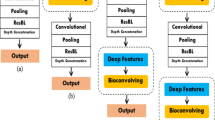Abstract
The security of biometric systems has always been a challenging area of research to safeguard against the day-by-day introduction of new attacks with the advancement in technology. Cancelable biometric templates have proved to be an effective measure against these attacks while ensuring an individual’s privacy. The proposed scheme uses a convolutional autoencoder (CAE) for feature extraction, a rank-based partition network, and a random network to construct secured cancelable biometric templates. Evaluation of the proposed secured template generation scheme has been done on the face and palmprint modalities.
Access this chapter
Tax calculation will be finalised at checkout
Purchases are for personal use only
Similar content being viewed by others
References
Cao, K., Jain, A.K.: Learning fingerprint reconstruction: from minutiae to image. IEEE Trans. Inf. Forensics Secur. 10(1), 104–117 (2014)
Deng, J., Dong, W., Socher, R., Li, L.J., Li, K., Fei-Fei, L.: ImageNet: a large-scale hierarchical image database. In: 2009 IEEE Conference on Computer Vision and Pattern Recognition, pp. 248–255. IEEE (2009)
Durstenfeld, R.: Algorithm 235: random permutation. Commun. ACM 7(7), 420 (1964)
Dusmanu, M., et al.: D2-Net: a trainable CNN for joint description and detection of local features. In: Proceedings of the IEEE/CVF Conference on Computer Vision and Pattern Recognition, pp. 8092–8101 (2019)
Feng, Y.C., Lim, M.H., Yuen, P.C.: Masquerade attack on transform-based binary-template protection based on perceptron learning. Pattern Recogn. 47(9), 3019–3033 (2014)
Glorot, X., Bordes, A., Bengio, Y.: Deep sparse rectifier neural networks. In: Proceedings of the Fourteenth International Conference on Artificial Intelligence and Statistics, pp. 315–323. JMLR Workshop and Conference Proceedings (2011)
Gomez-Barrero, M., Galbally, J., Rathgeb, C., Busch, C.: General framework to evaluate unlinkability in biometric template protection systems. IEEE Trans. Inf. Forensics Secur. 13(6), 1406–1420 (2018). https://doi.org/10.1109/TIFS.2017.2788000
Hammad, M., Liu, Y., Wang, K.: Multimodal biometric authentication systems using convolution neural network based on different level fusion of ECG and fingerprint. IEEE Access 7, 26527–26542 (2018)
He, K., Zhang, X., Ren, S., Sun, J.: Deep residual learning for image recognition. In: Proceedings of the IEEE Conference on Computer Vision and Pattern Recognition, pp. 770–778 (2016)
Ide, H., Kurita, T.: Improvement of learning for CNN with ReLU activation by sparse regularization. In: Proceedings of the International Joint Conference on Neural Networks, vol. 2017-May, pp. 2684–2691 (2017)
Jain, A.K., Nandakumar, K., Nagar, A.: Biometric template security. EURASIP J. Adv. Signal Process. 2008, 1–17 (2008)
Jang, Y.K., Cho, N.I.: Deep face image retrieval for cancelable biometric authentication. In: 2019 16th IEEE International Conference on Advanced Video and Signal Based Surveillance (AVSS), pp. 1–8. IEEE (2019)
Kirch, W. (ed.): Pearson’s Correlation Coefficient, pp. 1090–1091. Springer, Netherlands, Dordrecht (2008). https://doi.org/10.1007/978-1-4020-5614-7_2569
Kumar, A.: Incorporating cohort information for reliable palmprint authentication. In: 2008 Sixth Indian Conference on Computer Vision, Graphics & Image Processing, pp. 583–590. IEEE (2008)
Li, S.Z., Chu, R., Liao, S., Zhang, L.: Illumination invariant face recognition using near-infrared images. IEEE Trans. Pattern Anal. Mach. Intell. 29(4), 627–639 (2007)
Liu, Y., Ling, J., Liu, Z., Shen, J., Gao, C.: Finger vein secure biometric template generation based on deep learning. Soft. Comput. 22(7), 2257–2265 (2017). https://doi.org/10.1007/s00500-017-2487-9
Lumini, A., Nanni, L.: An improved biohashing for human authentication. Pattern Recogn. 40(3), 1057–1065 (2007)
Mai, G., Cao, K., Lan, X., Yuen, P.C.: Secureface: face template protection. IEEE Trans. Inf. Forensics Secur. 16, 262–277 (2020)
Mai, G., Lim, M.H., Yuen, P.C.: Binary feature fusion for discriminative and secure multi-biometric cryptosystems. Image Vis. Comput. 58, 254–265 (2017)
Nandakumar, K., Jain, A.K.: Biometric template protection: bridging the performance gap between theory and practice. IEEE Signal Process. Mag. 32(5), 88–100 (2015)
Phillips, T., Zou, X., Li, F., Li, N.: Enhancing biometric-capsule-based authentication and facial recognition via deep learning. In: Proceedings of the 24th ACM Symposium on Access Control Models and Technologies, pp. 141–146 (2019)
Ratha, N.K., Connell, J.H., Bolle, R.M.: Enhancing security and privacy in biometrics-based authentication systems. IBM Syst. J. 40(3), 614–634 (2001)
Samaria, F.S., Harter, A.C.: Parameterisation of a stochastic model for human face identification. In: Proceedings of 1994 IEEE Workshop on Applications of Computer Vision, pp. 138–142. IEEE (1994)
Siddhad, G., Khanna, P., Ojha, A.: Cancelable biometric template generation using convolutional autoencoder. In: Singh, S.K., Roy, P., Raman, B., Nagabhushan, P. (eds.) CVIP 2020. CCIS, vol. 1376, pp. 303–314. Springer, Singapore (2021). https://doi.org/10.1007/978-981-16-1086-8_27
Simonyan, K., Zisserman, A.: Very deep convolutional networks for large-scale image recognition. arXiv preprint arXiv:1409.1556 (2014)
Singh, A., Arora, A., Jaswal, G., Nigam, A.: Comprehensive survey on cancelable biometrics with novel case study on finger dorsal template protection. J. Bank. Financ. Technol. 4(1), 37–52 (2020). https://doi.org/10.1007/s42786-020-00016-z
Sudhakar, T., Gavrilova, M.: Multi-instance cancelable biometric system using convolutional neural network. In: 2019 International Conference on Cyberworlds (CW), pp. 287–294. IEEE (2019)
Sui, Y., Zou, X., Du, E.Y., Li, F.: Design and analysis of a highly user-friendly, secure, privacy-preserving, and revocable authentication method. IEEE Trans. Comput. 63(4), 902–916 (2013)
Talreja, V., Valenti, M.C., Nasrabadi, N.M.: Multibiometric secure system based on deep learning. In: 2017 IEEE Global Conference on Signal and Information Processing (globalSIP), pp. 298–302. IEEE (2017)
Wayman, J.L., Jain, A.K., Maltoni, D., Maio, D.: Biometric Systems: Technology, Design and Performance Evaluation. Springer Science & Business Media, Heidelberg (2005). https://doi.org/10.1007/b138151
Zhang, D.: Polyu palmprint database. Biometric Research Centre, Hong Kong Polytechnic University (2006). http://www.comp.polyu.edu.hk/biometrics/
Zhang, K., Zhang, Z., Li, Z., Qiao, Y.: Joint face detection and alignment using multitask cascaded convolutional networks. IEEE Signal Process. Lett. 23(10), 1499–1503 (2016)
Author information
Authors and Affiliations
Corresponding author
Editor information
Editors and Affiliations
Rights and permissions
Copyright information
© 2022 The Author(s), under exclusive license to Springer Nature Switzerland AG
About this paper
Cite this paper
Bamoriya, P., Siddhad, G., Khanna, P., Ojha, A. (2022). Cancelable Template Generation Using Convolutional Autoencoder and RandNet. In: Raman, B., Murala, S., Chowdhury, A., Dhall, A., Goyal, P. (eds) Computer Vision and Image Processing. CVIP 2021. Communications in Computer and Information Science, vol 1567. Springer, Cham. https://doi.org/10.1007/978-3-031-11346-8_32
Download citation
DOI: https://doi.org/10.1007/978-3-031-11346-8_32
Published:
Publisher Name: Springer, Cham
Print ISBN: 978-3-031-11345-1
Online ISBN: 978-3-031-11346-8
eBook Packages: Computer ScienceComputer Science (R0)




